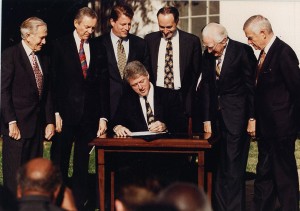
Care is vital in RFRA wordsmithing and advocacy
(by Chelsea Langston)
In May, 2015, additional states are considering legislation to protect the exercise of individual and organizational religious freedom—state RFRAs and similar bills. Given how controversial such efforts have been in states like Indiana and Arkansas, it is imperative that state lawmakers be judicious with the wording of such proposed laws and in the way they express the spirit and purpose of the laws to the public.
Congress passed the Religious Freedom Restoration Act (RFRA) in 1993 in response to the Supreme Court’s ruling in the Smith case. In Smith, the Court said that, because a law about illegal drugs was general and not targeted to harm religion, it could be applied against a Native American man who claimed that he smoked peyote, an illegal drug, as part of a religious ceremony. Congress considered that such an interpretation of religious freedom was inadequate and adopted RFRA as a remedy. RFRA says that if a generally applicable law substantially burdens a person’s sincere exercise of their religion, the law can only be applied if the government can prove it has a compelling interest for the burden and there is no less burdensome way to protect that interest. Four years later, in City of Boerne v. Flores, the Supreme Court ruled RFRA applies only to the federal government and not to the states. In response, many states have adopted their own state RFRAs or have amended their constitutions to reflect the RFRA principles.
In 2015, multiple states have considered legislation based, closely or loosely, on RFRA. RFRA bills have become controversial, in part because the federal RFRA protected Hobby Lobby’s religious claim not to include certain birth control methods in its health plan and in part because of the perception that state RFRAs might be used by religious business owners to protect a refusal to serve gay customers. In truth, despite the fears of RFRA opponents and the hopes of (some) RFRA supporters, the courts have never interpreted RFRA to justify rank discrimination, such as a restaurant turning away a gay couple. Whether or not a court might rule that a state RFRA law will protect a religious small business from assisting with a gay wedding, if the business owners have a sincere religious belief that marriage is a religious ceremony restricted to opposite-sex couples, is up in the air.
It is essential for state lawmakers, religious groups, and citizens to closely monitor the exact language of any proposed law modeled after RFRA. As the Baptist Joint Committee’s Executive Director Brent Walker states: “federal RFRA embodies a delicately balanced formula by which courts can adjudicate religious liberty claims while seeking to protect important interests of society generally or the well-being of third parties adversely affected by the requested accommodation.” States considering passage of a RFRA would do well to keep their language as close as possible to the federal statute, both because the federal statute has done a pretty successful job at upholding religious exercise in the past 20 years and because following precedent helps to insulate a bill from outlandish charges.
Issues with state RFRAs arise when, as Walker aptly puts it, “proponents of state legislation want to change the language of their bills to promote their own policy agendas or to disadvantage that of their political opponents.” This happens when states adopt RFRA-like language that actually throws off the equilibrium of the balancing test. For example, some states have taken “substantial” out of the requirement that a claimant prove that a generally applicable law is a “substantial burden” on their religious exercise. This is problematic because it not only tilts the rights pendulum too far on the plaintiff’s religious freedom side, it inevitable produces suspicion at best and vitriol at worst from opponents.
With bills currently before many state legislatures, the other key that state lawmakers and governors must keep in mind is rhetoric and public perception. Proponents of state RFRAs must, because of situations like Indiana, overcompensate in developing clear messaging with tangible examples about HOW RFRA works to protect minority beliefs and minority religious practices, WHY it does not provide a general license to discriminate, and WHAT its relation is to sexual orientation and gender identity nondiscrimination laws. State RFRAs play an important role in protecting religious actors from state and local laws that could harm their ability to practice their faith. But if policymakers are not careful with the language of religious freedom statutes and the messaging attached to such laws, they run the very real risk that they will create more problems than they solve and further sour public opinion against necessary accommodations for religious exercise.
So what kind of messaging works? Advocates of state RFRAs should take a page from Douglas Laycock’s playbook. Professor Laycock is a supporter of same-sex marriage and a staunch advocate of religious liberty. In an interview responding to Indiana’s RFRA, Laycock emphasized the importance of tolerance. “It is meaningless to say that you support religious liberty only so long as the religious practice isn’t anything you seriously disagree with. . . Just as we protect the freedom to say things we disagree with, we have to protect the liberty of religions we disagree with.” This is exactly what state RFRAs, and similar laws, aim to do. Although some bills come up short or have struck the wrong balance, these laws are, at their core, a mechanism for providing religious actors with a chance to be heard in court and have their rights and interests weighed against the interests of the state.
Resource for tracking state RFRAs: Baptist Joint Committee on Religious Liberty State RFRA Bill Tracker
